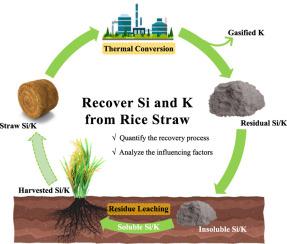Journal of Environmental Chemical Engineering ( IF 7.7 ) Pub Date : 2021-01-09 , DOI: 10.1016/j.jece.2021.105057 Zihao Yang , Xin Li , Xiao He , Yangsheng Liu

|
Retaining more soluble silicon (Si) and potassium (K) in the residue after the thermal conversion of straw and returning the residue to farmland as fertilizer can promote the sustainable supply of Si and K in farmland and alleviate the disposal pressure of the residue. In this study, rice straw was thermally converted at 350–850 °C under N2/air/CO2 atmospheres and the residues were leached for seven days to recover Si and K. Factors influencing recovery were analyzed with characterization data and recovery indicators. The results show that phytoliths dissolution affected the co-release of Si and K from residues produced below 650 °C or at 750 °C under CO2 atmosphere. The Brunner−Emmet−Teller specific surface area of residues had logarithmic positive correlations with Si recovery rate above 750 °C and K recovery rate in oxidizing environments. The total amount and content of soluble K in the residue had linear positive correlations with Si recovery rate. Residues with composite silicates or potassium carbonate tended to have lower Si recovery rates. The total K in rice straw was mainly lost by converted from soluble K to kinetically-insoluble K (≥14.5%) and oxidized-gasified K (≥19.8%), compared with thermodynamically-insoluble KAlSi3O8 (≤ 9.4%) and inert-gasified KCl (≤ 12.7%), respectively. The current straw thermal conversion technology can be improved concerning the above influencing factors to generate residues with more soluble Si and K, and to achieve both energy utilization of straw and resource utilization of residues.
中文翻译:

通过热转化和残渣浸出从稻草中回收硅和钾
秸秆热转化后,在残留物中保留更多的可溶性硅(Si)和钾(K),并将残留物作为肥料返回农田,可以促进农田中硅和钾的可持续供应,并减轻残留物的处置压力。在这项研究中,稻草在N 2 /空气/ CO 2气氛下于350–850°C进行热转化,并将残留物浸出7天以回收Si和K。使用表征数据和回收指标分析了影响回收率的因素。结果表明,硅藻土的溶解会影响硅和钾从650°C以下或750°C下在CO 2下产生的残留物中的共释放大气层。残留物的Brunner-Emmet-Teller比表面积与氧化环境中750°C以上的Si回收率和K回收率呈对数正相关。残留物中可溶性钾的总量和含量与硅的回收率呈线性正相关。具有复合硅酸盐或碳酸钾的残渣往往具有较低的硅回收率。与热力学上不溶的KAlSi 3 O 8相比,稻草中的总钾主要通过将可溶性K转化为动力学上不溶的K(≥14.5%)和氧化气化K(≥19.8%)而损失。(≤9.4%)和惰性气化的KCl(≤12.7%)。考虑到上述影响因素,可以对目前的秸秆热转化技术进行改进,以产生更具可溶性的Si和K的残渣,并实现秸秆的能源利用和残渣资源的利用。


























 京公网安备 11010802027423号
京公网安备 11010802027423号